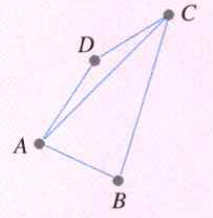For a prism ∠A+∠D=∠i+∠e= _______
To solve the equation for a prism where angle A+angle D=angle i+angle e, we can follow these steps:
Step 1: Understand the Angles
- Angle A is the angle of the prism.
- Angle D is the angle of deviation.
- Angle i is the angle of incidence.
- Angle e is the angle of emergence.
Step 2: Recall the Properties of a Prism
In a prism, the sum of the angles related to the light ray passing through it can be described using the following relationship:
angle A+angle D=angle i+angle e
Step 3: Establish the Relationship
From the properties of light refraction through a prism, we know that:
- The deviation angle D can be expressed as:
D=i+e−A
This means that the total deviation is equal to the sum of the angles of incidence and emergence minus the angle of the prism.
Step 4: Rearranging the Equation
Rearranging the equation gives us:
A+D=i+e
This confirms that the relationship holds true.
Step 5: Conclusion
Thus, we can conclude:
angle A+angle D=angle i+angle e
Final Answer
The equation angle A+angle D=angle i+angle e is true.
---
- Angle A is the angle of the prism.
- Angle D is the angle of deviation.
- Angle i is the angle of incidence.
- Angle e is the angle of emergence.
In a prism, the sum of the angles related to the light ray passing through it can be described using the following relationship:
angle A+angle D=angle i+angle e
From the properties of light refraction through a prism, we know that:
- The deviation angle D can be expressed as:
D=i+e−A
This means that the total deviation is equal to the sum of the angles of incidence and emergence minus the angle of the prism.
Rearranging the equation gives us:
A+D=i+e
This confirms that the relationship holds true.
Thus, we can conclude:
angle A+angle D=angle i+angle e
The equation angle A+angle D=angle i+angle e is true.
Topper's Solved these Questions
- LIGHT ENERGYBOOK - ICSECHAPTER - LIGHT ENERGYEXERCISE - EXERCISE-5.4 (Objective Type Questions) D. Tick the most appropriate answer.
5 Videos
- LIGHT ENERGYBOOK - ICSECHAPTER - LIGHT ENERGYEXERCISE - EXERCISE-5.4 (Objective Type Questions) E. Match the statements in column A, with those in Column B.
1 Videos
- LIGHT ENERGYBOOK - ICSECHAPTER - LIGHT ENERGYEXERCISE - EXERCISE-5.4 (Objective Type Questions) B. Statements given below are incorrect. Write the correct statements.
5 Videos
- HEAT TRANSFER BOOK - ICSECHAPTER - HEAT TRANSFER EXERCISE - Picture Study
2 Videos
- MATTER BOOK - ICSECHAPTER - MATTER EXERCISE - THEME ASSIGNMENT
25 Videos
Similar Questions
For an equilateral prism ∠A+∠i=∠e+∠D
View SolutionFind ∠A+∠B+∠C+∠D

View SolutionIn ΔDEFandΔPQR, it is given that ∠D=∠Qand∠R=∠E, then which of the following is not true?
View SolutionIn a pentagon ABCDE, AB is parallel to DC and ∠A:∠E:∠D=3:4:5. Find angle E.
View SolutionIn a hexagon, ABCDEF, side AB is parallel to side FE and ∠B:∠C:∠D:∠E=6:4:2:3 Find ∠Band∠D.
View SolutionHow does the angle of deviation formed by a prism change with the increase in the angle of incidence ?
Draw a graph showing the variation in the angle of deviation with the angle of incidence at a prism surface.
View SolutionFor a ray of light refracted through a prism of angle 60∘, the angle of incidence is equal to the angle of emergence, each equal to 45∘. Find the refractive index of the material of the prism.
View SolutionGiven : In quadrilateral ABCD, ∠C=64∘,∠D=∠C−8∘,∠A=5(a+2)∘and∠B=2(2a+7)∘. Calculate ∠A.
View SolutionThe angle between the incident ray and the emergent ray in case of a prism is called angle of prism. _________
View SolutionIn a pentagon ABCDE, AB is parallel to DC and ∠A:∠E:∠D=3:4:5. Find angle E.
View Solution
